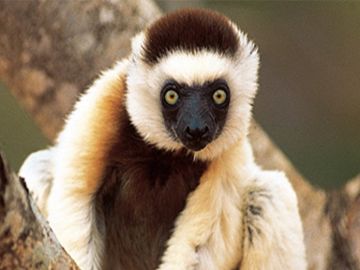Madagascar. The name alone is exotic and conjures images of a mystical place. And somewhere I had longed to go for some time. Lying off the south east coast of Africa, this island – almost three times the size of Britain – is home to some amazing and unique flora and fauna. Most notably the lemurs, with around 70 species, all endangered, and most of the world’s chameleons. But there is so much more, and new discoveries are still being made. This is what most of the group had come for, and we were not to be disappointed. Landing in Tana (the shortened name for the capital, Antananarivo) we headed east out to Perinet National Park, or d’Andasibe as it is now known, for our two-night stay. Geared up and excited at the prospect of our first lemur sightings we made an early start the next morning and were barely into the rainforest when we heard the haunting cries, not unlike whale song, of the Indri, the largest of the lemurs. Venturing further in it was not long before we spotted Woolly lemurs and Diademed Sifaka, trying to position ourselves amongst the foliage to get the best views and photos. Dragging ourselves away, we spent the afternoon in the lesser-visited Mantadia National Park, but no less sightings – the cute Bamboo lemur, Brown lemur, chameleons, frogs and unfortunately a leech or two… On a night walk that evening we even managed to see the tiny Mouse lemur and various small chameleons, some only the size of your thumb! Back through the beautiful and ever changing landscape we started our journey south. From winding roads through rocky mountains, to volcanic crater lakes, through sapphire country like something from the wild west. We also past rolling hills, grassy plains and storybook-like villages dotted amongst the paddyfields. It almost felt like you were in a different country every hour! We had an unscheduled stop in a small roadside village for a leg stretch and were welcomed into one of the families’ houses – they were as curious about us as we were about them. I found the Malagasy people, as they are known, always friendly and welcoming despite their hardships, I only wished I’d brushed up on my French before arrival! We reached the Fianarantosa region and the wonderful Parc National de Isalo. In the morning we walked into the sacred Canyon des Makis, where we caught a glimpse of a family of ring tail lemurs and another of sifaka (being filmed by a BBC documentary camera crew). On leaving the canyon we were escorted by some local children, giggling and skipping alongside us, and after a lunch break we hiked to the Piscine Naturelle (natural pool), Isalo’s most visited spot. Stopping to view different insects along the way, looking for scorpions and past sacred burial grounds of local elders, reaching the pool was truly like stumbling across an oasis – just beautiful. A well-deserved dip was definitely warranted and better still, we had the place to ourselves. In the evening we had a great night out at a local “hotely”, with live music and dancing. The food in Madagascar is amazing, with both French and Asian influence. I had some of the tastiest steaks I’ve ever eaten and delicious fresh seafood, and the vegetarians certainly don’t miss out either. The local wine however, is somewhat of an acquired taste, but the vanilla scented rum is not to be missed! We drove on to the west coast town of Tulear for an overnight stop before a flight north the next morning to Morondava and checked into our beach bungalows with a free afternoon sunning ourselves. A bumpy and dusty ride in 4×4‘s, with a couple of ferry river crossings thrown in, I loved the long journey up to Bekopaka – our base for exploring the amazing Tsingy de Bemahara, UNESCO World Heritage site. Our first day began with a two hour boat trip along the Manambolo River in traditional wooden pirogues. We explored caves, saw some tombs of the Vazimba tribe and spotted various birdlife, including a fish eagle who swooped down and plucked a catch from the river. In the afternoon we ventured into the Petit Tsingy. An incredible landscape of jagged, limestone pinnacles and a maze to traverse. But the best was yet to come the following day in the Grands Tsingy, where the pinnacles were even higher, chasms narrower, as well as ladders, rope bridges and caves to negotiate – it was not for the faint hearted, but the rewards were more than worth the effort! Tsingy was a real highlight of the trip for all. On our return journey we reached the outskirts of Morondava, and the famous Avenue du Baobab late afternoon. I have always had a fascination with majestic baobab trees for some reason, and to stand amongst these giants, that are up to 1000 years old, to watch the sunset is something I will never forget. I had always viewed Madagascar as an extension of Africa, but it really is its own entity. While the ongoing political situation has certainly seen tourism drop dramatically, it should not deter you from visiting this beautiful country. And I can’t wait to return… Lyndal has just returned from our Madagascan Discoverer .
Journalist Leo Bear travelled with Exodus to Madagascar for The Metro. Read about here trip in her article -> Madagascar is full of the spice of life.




